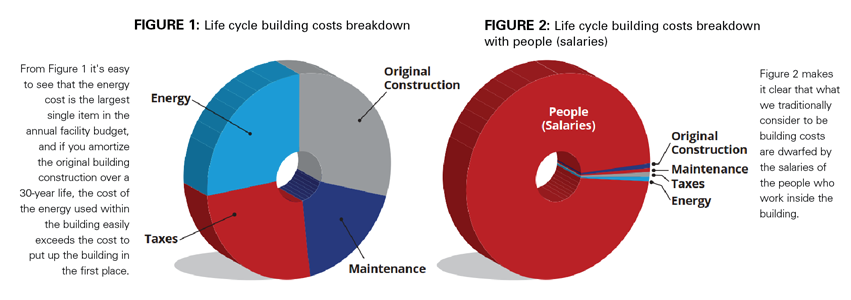
Use system data and building automation technologies to help achieve the perfect balance.
When I was asked to write an article connecting the building automation and temperature controls industry with energy efficiency, my mind went to a comfortable place. Several industry topics and control strategies instantly come to mind. For example, Demand Controlled Ventilation (DCV)—which is based on interior CO2 levels—can help reduce unwanted outside air infiltration in commercial buildings and can be a great opportunity for overall energy savings. Newly developed APIs [application program interface: specifications for how software components should interact] utilize advanced temperature control system scheduling to accurately schedule your building operations without direct access to the Building Automation System (BAS). This can greatly reduce runtime and equipment operation. And the list goes on.
Instead, I elected to cover the latest buzzword (or phrase) that has penetrated our industry the last couple of years: Big Data. This rather ambiguous expression can be applied to nearly every industry or market in the world today. In the building automation system and temperature controls industry, it can be described as the advanced collection and analysis of system data, which are processed to develop unique control algorithms resulting in increased energy savings, system reliability and increased occupant comfort.
Sounds kind of boring, right? Not when you see the effect it can have on your bottom line… and not just referring to a reduced utility bill.
“Our people are the organization’s most valuable asset”
It’s a phrase commonly used by a company’s president or CEO, which likely receives more eyerolls from employees than nods of agreement. But in fact, this statement is 100-percent true—based on the actual data. The salaries of employees who occupy a typical commercial office building dwarf the operating expenses required to construct and maintain the building itself. While the physical building is certainly an asset to the company or organization, once it is constructed and the people are inside, building owners tend to focus more on the operating costs, and less on the comfort level of those who are “our most valuable asset.”
To contemplate how quickly occupant comfort can affect productivity, simply recall your work environment or office space the last time the air conditioning went out. The reaction, no matter where you work, is typically the same. Most individuals will take a break from their job duties to express their discomfort to the nearest co-worker, or even gather as a group to chat about how hot it is. This behavior can last hours and—depending on the number of employees affected—can cost the organization thousands of dollars in lost productivity.
Now envision a tool that can process real-time data to predict a potential equipment failure and notify key personnel that preventative maintenance is needed. That pattern detection and predictive analysis is the essence of Big Data.
Longtime Friends of Big Data
The best example of a successful “Big Data” company is probably Facebook. When it went public in 2012, the peak market capitalization for the company was more than $100 billion. Many asked at the time, “How can a social media company that (on the surface) doesn’t produce a physical product for consumption be worth so much money?” The simple answer is: data. Tons of data, to be exact.
Every successful social media app is measured by the number of active users, and these users ultimately act as the employees of these businesses. As “employees,” we are—sometimes unknowingly—very productive for our employer, providing massive amounts of valuable data about our daily activities and habits that can be harvested by the app for analysis and distribution to advertisers.
So how are these companies successful in attracting and retaining good “employees,” and how could it relate to your organization and building? Simply put… they make us comfortable. In fact, the apps are so comfortable to the end user that their use becomes habitual. Further, they work tirelessly to ensure that user “comfort” and their valuable data mine is never threatened. By constantly releasing information and updates regarding security, improved features or device compatibility, the users stay engaged, at ease and productive.
Shouldn’t your organization match this model? What tools or products can you use to keep your staff engaged, at ease and productive?

Achieving the Balance
There is an ideal balance that all responsible building owners and operators strive for: maintaining the highest level of building efficiency while simultaneously maintaining the highest level of occupant comfort. This is easier said than done. Implementing responsible energy reduction measures without sacrificing the comfort level of the building occupants can be tricky. Like our social media friends, we must also possess the proper tools to continually collect and process system data in order to adjust with our ever-changing environment.
Fortunately, there are several features of a modern BAS that can utilize real-time data to self-diagnose and self-correct building operations, while simultaneously providing both energy efficiency and occupant comfort benefits. Some of these features include:
- Comfort measurement tools. By continuously collecting and processing the building’s temperatures, relative humidity levels and carbon dioxide levels during occupied times, we can accurately calculate a percentage of occupant comfort. This figure becomes a key component to every equation moving forward and must be used when verifying the success of any energy improvement strategy.
- Thermographic indicators. The modern BAS can provide the end user with visual indicators of zone temperature conditions using unique colors. These indicators are a powerful tool used to quickly determine the comfort level of an entire building or zone. Trouble areas can be identified and solutions can sometimes be implemented before an occupant complaint is issued.
- Fault detection & diagnosis. FDD is a powerful and complex algorithm that is uniquely created for each system to measure, anticipate and diagnose system conditions. This predictive analytic can result in the reduction or elimination of equipment downtime and also ensure occupant comfort is maintained. The use of FDD can help alert building staff of the need for maintenance and ensure critical equipment remains online during peak conditions.
- Optimal room temperature setpoint adjust and startup. Referencing factors such as outside air temperature, room temperature and historical data, modern systems can automatically adjust parameters to ensure the occupant enters a space that is comfortable to them. This feature simultaneously enables the HVAC system to be properly scheduled and reduce overall equipment runtime.
Energy-saving measures can certainly improve your bottom line and open up valuable funds to hire (or retain) key personnel, make capital investments or even explore a green initiative. And if those savings can be achieved while providing an ideal working environment for your most valuable asset, you’ve achieved perfect balance. And that is a story worth sharing. iBi
Erik Fehl is a LEED Green Associate and Account Executive at Environmental Control Solutions, Inc., the field office for Automated Logic serving central Illinois and eastern Iowa. For more information on building automation systems, visit ecsi-alc.com.

